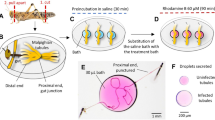Abstract
Insects regulate the amount of water they excrete via their nalpighian tubules, the degree of stringency depending on the hydration of their diet and on the frequency at which they feed. The excretion of water is controlled by a diuretic hormone, which is released as required into the haemolymph by the corpora cardiaca1,2. Previous reports3–5 have shown that non-protein amino acids, known to be neurotoxic in vertebrates6 as well as in insects7, lead to a disruption of water balance in nsects. However, the exact mode of action of these amino acids has not been elucidated. We report here on preliminary experiments using isolated malpighian tubules of locusts Locusta migratoria migratorioides (R & F)) which 9 show that he non-protein amino acid L-canavanine inhibits fluid secretion in vitro by isolated tubules. Furthermore, when tubules, previously inhibited by canavanine, are subsequently stimulated by exogenous diuretic hormone (methanol extracts of storage lobes of corpora cardiaca1,2) or cyclic AMP (which mimics the action of diuretic hormone1), the stimulation obtained is much greater than that normally expected from diuretic hormone or cyclic AMP.
This is a preview of subscription content, access via your institution
Access options
Subscribe to this journal
Receive 51 print issues and online access
$199.00 per year
only $3.90 per issue
Buy this article
- Purchase on Springer Link
- Instant access to full article PDF
Prices may be subject to local taxes which are calculated during checkout
Similar content being viewed by others
References
Rafaeli, A. & Mordue, W. Gen. comp. Endocr. 34, 110 (1977).
Mordue, W. J. Insect. Physiol. 15, 273–285 (1969).
Dahlman, D. L. Ent. Exp. Appl. 24, 127–135 (1978).
Dahlman, D. L. & Rosenthal, G. A. J. Insect. Physiol. 22, 265–271 (1976).
Schlesmger, H. M., Applebaum, S. W. & Birk, Y. J. Insect. Physiol. 22, 1421–1425 (1976).
Ressler, C., Redstone, P. A. & Erenberg, R. H. Science 134, 188–190 (1961).
Kammer, A. E., Dahlman, D. L. & Rosenthal, G. A. J. exp. Biol. 75, 123–132 (1978).
Maddrell, S. H. P. J. exp. Biol. 51, 71–97 (1969).
Rafaeli, A. & Mordue, W. Physiol. Ent. 3, 59–63 (1978).
Pilcher, D. E. M. J. exp. Biol. 52, 653–665 (1970).
Author information
Authors and Affiliations
Rights and permissions
About this article
Cite this article
Rafaeli, A., Applebaum, S. Canavanine potentiates the response of insect malpighian tubules to diuretic hormone and cyclic AMP. Nature 283, 872–873 (1980). https://doi.org/10.1038/283872a0
Received:
Accepted:
Issue Date:
DOI: https://doi.org/10.1038/283872a0
Comments
By submitting a comment you agree to abide by our Terms and Community Guidelines. If you find something abusive or that does not comply with our terms or guidelines please flag it as inappropriate.



